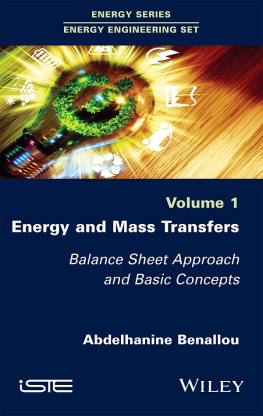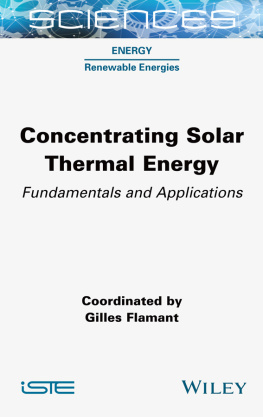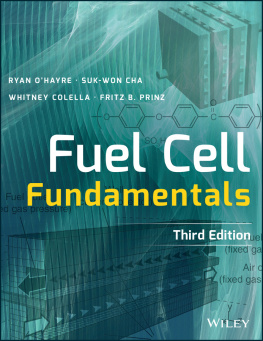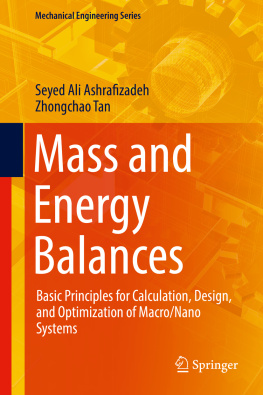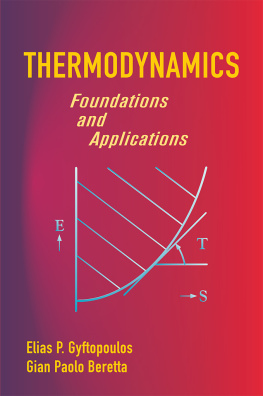
Energy Engineering Set
coordinated by
Abdelhanine Benallou
Volume 3
Energy Transfers by Convection
Abdelhanine Benallou

First published 2019 in Great Britain and the United States by ISTE Ltd and John Wiley & Sons, Inc.
Apart from any fair dealing for the purposes of research or private study, or criticism or review, as permitted under the Copyright, Designs and Patents Act 1988, this publication may only be reproduced, stored or transmitted, in any form or by any means, with the prior permission in writing of the publishers, or in the case of reprographic reproduction in accordance with the terms and licenses issued by the CLA. Enquiries concerning reproduction outside these terms should be sent to the publishers at the undermentioned address:
ISTE Ltd
2737 St Georges Road
London SW19 4EU
UK
www.iste.co.uk
John Wiley & Sons, Inc.
111 River Street
Hoboken, NJ 07030
USA
www.wiley.com
ISTE Ltd 2019
The rights of Abdelhanine Benallou to be identified as the author of this work have been asserted by him in accordance with the Copyright, Designs and Patents Act 1988.
Library of Congress Control Number: 2018962094
British Library Cataloguing-in-Publication Data
A CIP record for this book is available from the British Library
ISBN 978-1-78630-276-2
Preface
The secret of change is to focus all your energy not on fighting the old, but on building the new.
Dan Millman (1946), artist, author, record-holder and sportsman
For several years, I have cherished the wish of devoting enough time to the writing of a series of books on energy engineering. The reason is simple: for having practiced for years teaching as well as consulting in different areas ranging from energy planning to rational use of energy and renewable energies, I have always noted the lack of formal documentation in these fields to constitute a complete and coherent source of reference, both as a tool for teaching to be used by engineering professors and as a source of information summarizing, for engineering students and practicing engineers, the basic principles and the founding mechanisms of energy and mass transfers leading to calculation methods and design techniques.
But between the teaching and research tasks (first as a teaching assistant at the University of California and later as a professor at the cole des mines de Rabat, Morocco) and the consulting and management endeavors conducted in the private and in the public sectors, this wish remained for more than twenty years in my long list of priorities, without having the possibility to make its way up to the top. Only providence was able to unleash the constraints and provide enough time to achieve a lifetime objective.
This led to a series consisting of nine volumes:
- Volume 1: Energy and Mass Transfers;
- Volume 2: Energy Transfers by Conduction;
- Volume 3: Energy Transfers by Convection;
- Volume 4: Energy Transfers by Radiation;
- Volume 5: Mass Transfers and Physical Data Estimation;
- Volume 6: Design and Calculation of Heat Exchangers;
- Volume 7: Solar Thermal Engineering;
- Volume 8: Solar Photovoltaic Energy Engineering;
- Volume 9: Rational Energy Use Engineering.
The present book is the third volume of this series. It concerns the study of convection heat transfer.
As we will see, the calculation methods established in this book present multiple applications in engineering: heat exchanger calculation, demand-side energy, improvement of heat dissipation in electronic circuits, etc.
A series of exercises is presented at the end of the book, aimed at enabling students to implement new concepts as rapidly as possible. These exercises are designed to correspond as closely as possible to real-life situations occurring in industrial practice or everyday life.
Abdelhanine BENALLOU
October 2018
Introduction
Whilst conduction is of great importance in the transmission of thermal energy through continuous media, particularly solid media, heat transfer in industrial equipment (heat exchangers, evaporators, etc.) very often involves exchanges between fluids (gas or liquid) and solid walls (Leontiev, 1985). Indeed, in most situations, we heat a liquid or gas by putting it in contact with a hot surface, or cool a fluid through contact with a cold surface. To resolve such problems, conduction equations are no longer applicable, given that there is a large difference: in convection, the fluid concerned is in motion.
In this document we will therefore be focusing on convective heat transfer between solids and fluids in motion.
Generally, the motion of the fluid is one of two types:
- It is induced by the temperature gradients existing in the system, without the intervention of any external device (pump, compressor or other). In this case we speak of natural or free convection.
- It is created by an external device that sets the fluid in motion (pump, fan, etc.). In this case we speak of forced convection.
Yet whether the motion is natural or forced, we are often faced with a problem where the equations describing the fluid dynamics are coupled with those reflecting the heat balance. It will therefore be necessary to simultaneously solve the equations reflecting the energy and momentum balances (Navier-Stokes equation: see Bird, Stewart and Lightfoot, 1975; Kays and Crawford, 1993; Giovannini and Bdat, 2012). The problem is therefore far from straightforward and this difficulty has driven various researchers to propose approximation methods leading to practical results.
Since the approximation proposed by Boussinesq (1901) to solve the natural convection equations, several analyses have been developed to provide answers to classic problems of thermal engineering, such as the transfer of heat to a fluid in forced circulation within a tube (the Graetz problem), the heat transfer between a fluid and a flat plate (the Blasius problem), or the heat transfer generated by Archimedes forces in natural convection (the Boussinesq problem).
These different analyses lead to solutions that may be implemented using numerical tools (Landau and Lifshitz 1989; Kays and Crawford 1993; Giovannini and Bdat, 2012). This is done using certain approximations, notably regarding the incompressibility of Newtonian fluids in forced convection. However, the validity of these approximations is sometimes disputed (Boussinesq approximation: see Lagre, 2015), and their real justification is, above all, related to the simplifications necessary in order to soften the "rebel" equations, as Boussinesq himself calls them:
Next page

